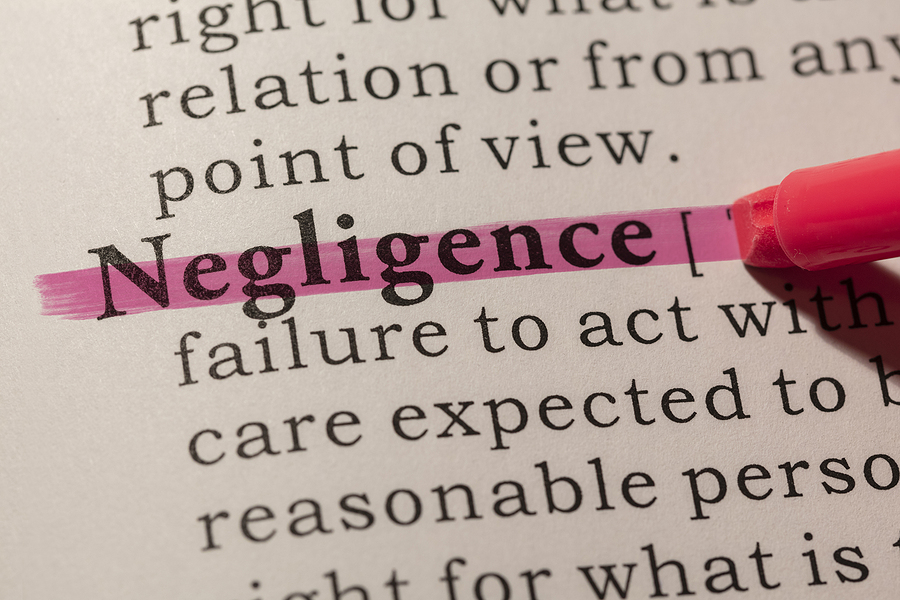If you were severely harmed in an accident because of another person’s reckless actions, you may have a right to obtain money for your injuries and the damages you sustained. Usually, most injury lawsuits or claims develop from incidents that involve an accidental injury. A victim is harmed by another individual’s actions or omissions. Examples include a car crash, a defective product accident, or a slip and fall incident, just to name a few.
However, before a victim can collect money for the hurt and damages they endured, they need to prove that another individual was responsible for their injuries and the expenses that resulted. Typically, this is done by showing the wrongful party acted negligently.
While proving negligence may seem like a simple task, that’s far from the truth. Victims often have to prove numerous legal standards before a case of negligence may even be considered. We’ve prepared this blog to help you understand what a prima facie case of negligence entails. Below, we hope to provide you with some information you need to know about negligence cases, including what they are, the proof that is required to bring a successful claim, and how an experienced personal injury lawyer can help you obtain the compensation and justice you deserve.
What Exactly Is Negligence?
Negligence is legally defined as a failure to behave with a level of care that a reasonable person would have exercised under the same or similar circumstances. Although negligent behavior usually consists of actions, it also consists of omissions when there is a duty to act.
When trying to figure out if a person’s behavior constitutes negligence, your lawyer must prove:
- There was an existence of a legal duty that the wrongdoer owed the victim (or the plaintiff)
- The wrongdoer breached this legal duty
- The plaintiff suffered an injury as a result
- There is proof that the wrongdoer’s breach caused the plaintiff’s harm (often shown through proximate cause)
How Do You Determine if a Legal Duty Existed?
Generally, the first step of a negligence case is determining if there was an existence of a legal duty that the wrongdoer owed to the plaintiff.
Usually, people—and companies—owe two types of duties:
- A special duty of care: This duty is often imposed by case law or statute, or the plaintiff has justifiably come to rely on a party’s assumption of that duty. For instance, take the specific Food and Drug statute indicating that drug products must have labels warning consumers of all the possible side effects the drugs can cause. When a drug manufacturer violates this statute, it could breach its duty of care.
- A general duty of care: This duty of care is a legal obligation imposed on an individual to conduct themselves in a manner that an individual of ordinary prudence would act under the same or similar circumstances. For example, to determine negligence following a car accident, you would need to figure out whether a reasonable person would have acted the way the wrongdoer did under the same or similar circumstance.
To figure out whether the plaintiff is owed a special duty or a general duty of care, the court will often look into the relationship between the wrongdoer and the plaintiff to decide.
How Can You Prove That an Individual Breached Their Duty of Care?
Once you can determine the appropriate duty of care, the plaintiff must then show how the wrongdoer breached this duty of care or failed to act in accordance with the appropriate standard. Typically, this is established by showing the proper duty of care and how the wrongdoer’s actions fell short of this specific standard.
When a court tries to determine whether there was a breach of duty of care, they first check to see if the wrongful party could foresee the risk of harm to the plaintiff and if they failed to stop this harm from occurring. They may also consider if other options could have prevented the plaintiff’s harm or injuries (such as whether the wrongful party could have taken other actions or used less dangerous materials.) However, the court will also take into account whether these safer alternatives were financially plausible or available for the wrongdoer to use or if they would’ve imposed a significant burden on their behalf.
Strict Liability
In some specific situations, it can be presumed there was a breach of duty of care based on the existence of certain elements and factors. What does this mean exactly? Let’s say a state has strict liability for abnormally dangerous activities. If an individual is harmed because of this dangerous activity, the wrongful party is presumed to have breached their duty of care and can be found liable for the incident. As a result, the plaintiff can recover compensation for their injuries and damages without having to show that the wrongdoer breached their duty of care.
Proving That the Plaintiff Suffered an Injury
The next step in a negligence case is proving that the plaintiff suffered an injury. Usually, these injuries will include bodily harm or harm to real or personal property.
Even though bodily injury can include various types of harm, the most common examples of bodily harm that are often cited in a negligence case include:
- Head and neck injuries
- Traumatic brain injuries
- Spinal cord damages
- Soft tissues injuries
- Broken or fractured bones
- Deep lacerations
- Significant burns
- Back injuries
- Failed or delayed diagnosis
- Development of an unfortunate health condition such as a heart attack or cancer
- Post traumatic stress disorder (PTSD)
- Wrongful death
Proving That the Breach of Duty Resulted in the Plaintiff’s Losses and Injuries
Proving that a plaintiff suffered an injury is not enough to show that the wrongdoer was responsible for the plaintiff’s accident and their harm. To bring a successful prima facie negligence case, the plaintiff also needs to establish that the wrongdoer’s breach of duty caused their injuries.
There are generally two types of causation that need to be addressed in order to prove this breach of duty. They include:
- Actual cause or the cause-in-fact: The cause-in-fact is a relatively straightforward concept and involves the plaintiff showing that the wrongdoer’s actions are the actual cause of their injuries. To establish this actual cause, the but-for test is used. For instance, if a motorist ran a stop sign and hit a motorcycle and the motorcyclist suffered brain damage, the but-for test would state that “but for the motorist running the stop sign, the motorcyclist would not have suffered brain damage.”
- Legal cause or proximate cause: On the other hand, legal or proximate cause deals with the issue of foreseeability and whether the plaintiff’s injuries were a foreseeable result of the wrongdoer’s behavior and actions. For example, if an individual decides to drink and drive and kills another motorist, it could have been foreseeable that when the individual got behind the wheel while intoxicated, death could have occurred. Yet, if the drunk driver hit a truck carrying hazardous material and caused an explosion that injured a motorist a significant distance away, it’s unlikely that this explosion accident could’ve been a foreseeable consequence of drunk driving.
Put more simply, when the plaintiff is trying to prove proximate cause, they need to show that the at-fault party’s actions set in motion a relatively short chain of events that could’ve been reasonably expected to lead to their harm and damages.
Collecting Damages—Understanding Whether the Plaintiff Deserves Compensation
The final element of a negligence case refers to damages and requires the plaintiff to show that they suffered significant damages and losses due to the wrongdoer’s negligence. Typically, these damages refer to compensation for the plaintiff’s injury, property repairs, lost wages, and medical care.
Different Types of Damages
If you can establish that another individual was responsible for your harm because of their negligent actions, you may be entitled to certain types of compensation. In general, this compensation includes:
Economic or general damages: These damages refer to the actual and verifiable losses that result from the accident and can include:
- Medical expenses including past, current, and future medical bills such as physician visits, hospital stay, surgeries, and prescription medications
- Lost wages
- Lost earning capacity
- Personal property damages
- At-home nursing care
- Rehabilitative therapy such as occupational and physical therapy
- Other out-of-pocket expenses
Non-economic or special damages: These damages often include subjective losses that are not easy to quantify. They can include:
- Pain and suffering
- Mental anguish
- Loss of companionship
- Loss of consortium
- Loss of enjoyment of life
- Loss of reputation
- Disfigurement
- Scarring
Punitive damages: Unlike the other compensatory damages (special and general damages), which compensate the victim for their losses, punitive damages punish the wrongful party for their egregious actions and aim to stop them and others from committing this act again in the future. Yet, in Texas, these damages are only awarded in exceptional cases, specifically when the plaintiff proves with clear and convincing evidence that the harm caused by the wrongful party resulted from malice, fraud, or gross negligence and not just from ordinary negligence or bad faith.
Different Types of Negligence Claims
Unfortunately, negligence cases involve a variety of circumstances, actions, and accidents.
Some of the most common examples of a negligence claim usually refer to:
- Motor vehicle crashes
- Truck accidents
- Motorcycle collisions
- Workplace accidents
- Defective product accidents
- Medical malpractice incidents
- Premises liability accidents
- Elder neglect
If you were harmed in an accident, it can be difficult to determine if your injuries resulted from another person’s negligence. Fortunately, when you work with an experienced personal injury attorney, you do not have to figure this out yourself. These lawyers can promptly get to work determining what happened, who was at fault, and whether you have a viable negligence case.
Do You Need a Personal Injury Attorney Helping You With Your Negligence Claim?
To bring a successful negligence claim, not only do you need to have a thorough understanding of the specific negligence laws, but it is also required that you provide sound legal arguments and evidence establishing the different negligence elements. Consequently, this whole process can be complicated and tedious without an experienced personal injury lawyer on your side. However, when you work with a trusted and knowledgeable injury attorney, you do not have to tackle this complex legal battle on your own.
An injury accident lawyer can handle these challenging negligence claims for you while also:
- Offering you the advice you need, evaluate your potential claims, and go over the legal options you can pursue.
- Discussing all of your concerns and questions and provide you with the support you need.
- Investigating the incident thoroughly and building the strongest possible claim by obtaining the evidence required to show fault and damages.
- Managing all the negotiations and discussions with the other side and the insurance company, and pursuing just compensation on your behalf.
- Bringing in experts such as economists, doctors, engineers, and accident reconstructionists to back up your claims.
- Taking your case to trial if the other side is unwilling to negotiate a fair settlement and work relentlessly to bring a successful resolution to your claim.
If you or a family member suffered serious injuries because of another person’s negligent actions, do not wait to get the legal support you need. Contact an experienced personal injury lawyer today for a free case consultation.





